Coronavirus (COVID-19): impact on wellbeing - research
This report contains the findings from a telephone survey commissioned by Scottish Government to better understand the impact of the COVID-19 pandemic on people in Scotland.
Chapter 4. Neighbourhood perceptions and support
This section includes neighbourhood perceptions and support provision during the pandemic.
Neighbourhood help
Respondents were asked how much they agree or disagree with the statement: 'If I was alone and needed help, I could rely on someone in this neighbourhood to help me'. As shown in Figure 21, the vast majority (81%) agreed with this statement, with 56% agreeing strongly.
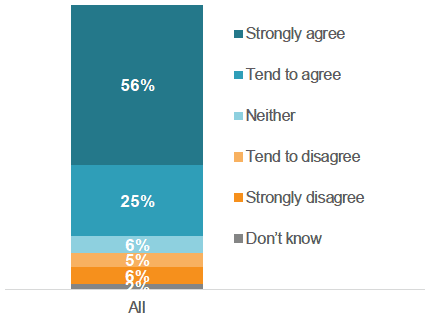
Base: All (1000)
Figure 21 Description
This bar chart shows the proportions of respondents who ‘strongly agree’, ‘tend to agree’, ‘tend to disagree’, and ‘strongly disagree’ with the statement. It also shows the proportion who ‘don’t know’ or answered ‘neither’. It indicates the majority (56%) strongly agree, and large minority (25%) tend to agree.
Subgroup differences - neighbourhood help
Women were more likely to agree strongly with this statement (62%) than men (50%).
As shown in Figure 22, those in rural areas were also more likely to agree strongly (66%) than those in urban areas (54%), while those in urban areas were more likely to disagree strongly (7%) than rural areas (2%).
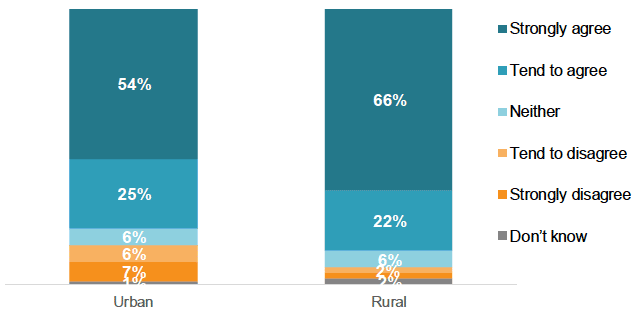
Base: All urban (791) Rural (167)
Figure 22 Description
This bar chart shows the proportions of respondents in two groups (‘Urban’ and ‘Rural’) who ‘strongly agree’, ‘tend to agree’, ‘tend to disagree’, and ‘strongly disagree’ with the statement. It also shows the proportion who ‘don’t know’ or answered ‘neither’. It indicates that 54% of those in urban areas strongly agree, compared with 66% in rural areas.
Those in older age groups were more likely to agree with this statement; 61% of those aged 55-69 and 71% of those 70+ strongly agreed compared with 47% of those aged 16-24. Those aged 16-24 were more likely to disagree (17%) than those aged 55-69 (8%) and 70+ (6%).
Those in the two most deprived areas were more likely to disagree strongly (10% and 9% respectively) than the two least deprived (4% and 1% respectively). Similarly, those in the second least deprived areas were more likely to agree strongly (65%) than those in the two least deprived (50% and 51% respectively).
Non-disabled respondents were more likely to agree (84%) than those who were disabled (74%). Disabled respondents were more likely to disagree (19%) than those who were not disabled (9%).
Neighbourhood trust
Respondents were also asked how much they agree or disagree with the statement: 'This is a neighbourhood where most people can be trusted'. As shown in Figure 23, the vast majority (81%) agreed with this statement, with 55% agreeing strongly. Only 10% disagreed.
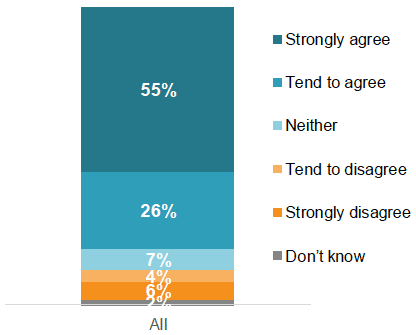
Base: All (1000)
Figure 23 Description
This bar chart shows the proportions of respondents who ‘strongly agree’, ‘tend to agree’, ‘tend to disagree’, and ‘strongly disagree’ with the statement. It also shows the proportion who ‘don’t know’ or answered ‘neither’. It indicates that the majority (55%) strongly agree, and large minority (26%) tend to agree.
Subgroup differences - neighbourhood trust
As shown in Figure 24, those in rural areas were more likely to agree strongly (65%) with this statement than those in urban areas (53%). Similarly, those in urban areas were more likely to disagree strongly (7%) than those in rural areas (3%).
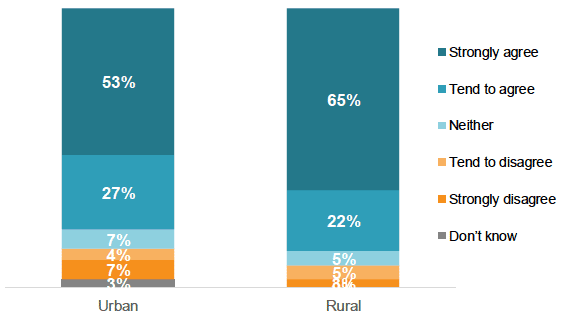
Base: All urban (791) Rural (167)
Figure 24 Description
This bar chart shows the proportions of respondents in two groups (‘Urban’ and ‘Rural’) who ‘strongly agree’, ‘tend to agree’, ‘tend to disagree’, and ‘strongly disagree’ with the statement. It also shows the proportion who ‘don’t know’ or answered ‘neither’. It indicates that 53% of those in urban areas strongly agree, compared with 65% in rural areas.
Those in the older three age groups (35-54, 55-69 and 70+) were also more likely to agree (83%, 89% and 91%) than those aged 16-24 and 25-34 (72% and 68% respectively). Similarly, those in the two oldest age groups 55-69 and 70+ were more likely to agree strongly (65% and 73% respectively) than those aged 16-24, 25-34 and 35-54 (41%, 44% and 52% respectively).
Those in the least deprived areas were more likely to agree strongly (68% and 70% respectively) than those in the most (32%,47% and 55% respectively). Those in the three most deprived areas were also more likely to tend to disagree (7%, 6% and 6% respectively) than the least deprived areas (1%). Similarly, those in the most deprived areas were more likely to disagree strongly (17%) than those in all other areas (7%, 6%, 1% and 2% respectively).
Non-disabled respondents were also more likely to agree strongly (57% compared with 49%), while disabled respondents were more likely to disagree strongly (10% compared with 4%).
Support and support sources
Respondents were asked if they had received support in the last month, from any source. The majority (73%) of respondents had received support in some form; as shown in Figure 25, the most common form of support was 'people getting in touch to check that you are okay' (63%). Around a fifth had had food shopping done for them (22%), support with existing or ongoing health conditions or other health-related items unrelated to COVID-19 (21%) and other people collecting prescriptions for them (18%). Over a quarter (27%) had received none of these kinds of help.
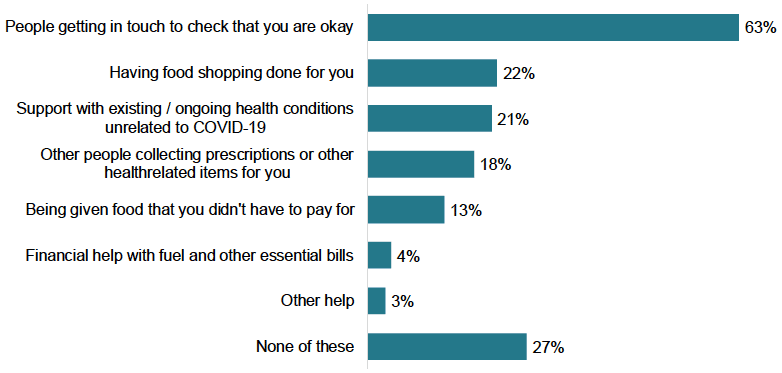
Base: All (1000)
Figure 25 Description
This bar chart shows the proportions of respondents who answered that they had received any of the following types of support in the last month: ‘People getting in touch to check you are okay’, ‘Having food shopping done for you’, ‘Support with existing/ ongoing health conditions unrelated to COVID-19’, ‘Other people collecting prescriptions or other health related items for you’, ‘Being given food that you didn’t have to pay for’, ‘Financial help with fuel and other essential bills’, ‘Other help’, or ‘None of these’. It shows that the most common response was ‘People getting in touch to check you are okay’, with 63% of people choosing this, followed by ‘None of these’.
Respondents who had received help in the last month were asked who provided them with this help. As shown in Figure 26, the most common answer was family (72%) followed by friends (53%). Minorities had received support from other sources, such as work colleagues (6%), their local council (5%) and support groups (5%).
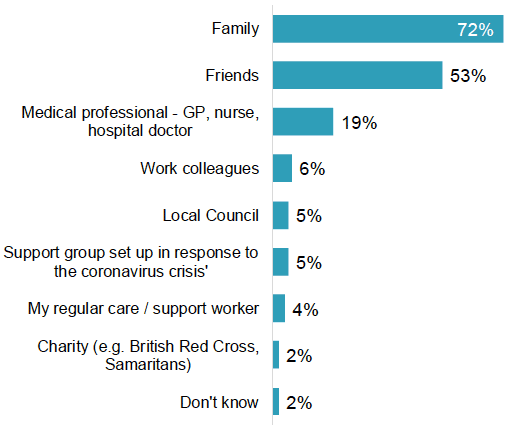
Base: All who have received help in the last month (733)
Figure 26 Description
This bar chart shows 9 different sources of support and the proportions of respondents who indicated having received help in the last month from a previous question (733 respondents), having received any of these. These sources are: ‘Family’, ‘Friends’, ‘Medical professional – GP, nurse, hospital doctor’, ‘Work colleagues’, ‘Local Council’, ‘Support group set up in response to the coronavirus crisis’, ‘My regular care/ support worker’, ‘ Charity (e.g. British Red Cross, Samaritans) and ‘Don’t know’. It shows that the most commonly reported source of support was ‘Family’ (72%), followed by ‘Friends’ (53%).
Subgroup differences - support
Women were more likely than men to have had people get in touch with them to check they were okay (67% compared with 59%), as well as having food shopping done for them (25% compared with 18%).
The oldest age group (70+) were more likely to have received support compared with those aged 16-24, 25-34, 35-54 and 55-69:
- People getting in touch with them to check that they are okay (86% compared with 59%, 55%, 59% and 64% respectively)
- Having food shopping done for them (60% compared with 15%, 13%, 17% and 18% respectively)
- Other people collecting prescriptions or other health-related items for them (33% compared with 14%, 16%, 15% and 16% respectively)
Those aged 70+ were also more likely to have received support with existing or underlying health conditions unrelated to COVID-19 (31%) than those aged 25-34 (17%) and 35-54 (18%).
Those in the least deprived areas were more likely to have had food shopping done for them (25%) than those in the most deprived (16%).
Disabled respondents were more likely to have had support than those without; including having food shopping done for them (32% compared with 19%), other people collecting prescriptions or other health related items for them (34% compared with 13%), being given food they didn't have to pay for (20% compared with 11%) and financial help (7% compared with 3%).
Subgroup differences - support sources
Of those who had received support, those aged 35-54 were more likely to have received this from friends (60%) than those aged 70+ (43%). Meanwhile, those aged 25-34 and 35-54 were more likely to have received help from their work colleagues (both 9%) than those aged 55-69 and 70+ (3% and 1% respectively). Those aged 55-69 were more likely to have received help from their local council (7%) than those aged 35-54 (2%).
Of those who had received support, those in the three least deprived areas were more likely to have received this from friends (56%-68%) than those in the most deprived (41%). Those in the least deprived areas were more likely to have received support from work colleagues (9%) than those in the most deprived (3%). Those in the two most deprived areas were more likely to have received support from a regular care or support worker (8% and 5% respectively) than those in the second most deprived (1%). In addition, those in the most deprived areas were more likely to have received support from a charity (5%) than those in the least deprived (1%).
Disabled respondents were more likely to have received support from a medical professional (28% compared with 16%), their care worker (7% compared with 3%), or a support group set up in response to the Coronavirus crisis (8% compared with 4%).
Further help
Respondents were asked if there was anything they needed help with but were not receiving. As shown in Figure 27, the majority (85%) did not need any further help. However, small minorities needed help with health conditions unrelated to COVID-19 (4%), financial help to pay for essentials (3%) and help to get shopping or medicines (3%).
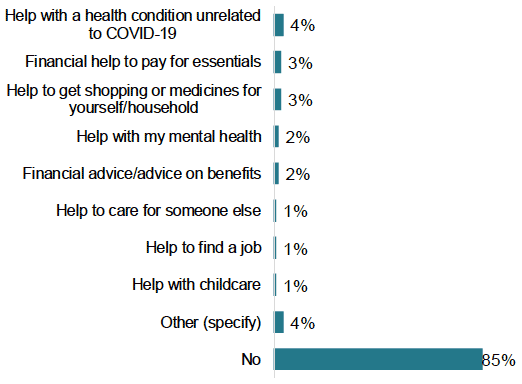
Base: All (1000)
Figure 27 Description
This bar chart shows 10 response options for types of further help needed and the proportions of respondents who indicated a need for this help. These types of help are: ‘Help with a health condition unrelated to COVID-19’, ‘Financial help to pay for essentials’, ‘Help to get shopping or medicines for yourself/ household’, ‘Help with my mental health’, ‘Financial advice/advice on benefits’, ‘Help to care for someone else’, ‘Help to find a job’, ‘Help with childcare’, ‘Other’ or responded ‘No’. It shows the majority (85%) indicated they need no further help, while 4% answered ‘Other’ and another 4% answered ‘Help with a health condition unrelated to COVID-19’.
Subgroup differences - further help
Women were more likely to say they required further help than men, including with a health condition unrelated to COVID-19 (6% compared with 2%) and their mental health (4% compared with 1%).
Those aged 16-24 and 25-34 were more likely to say they needed help with their mental health (4% and 5% respectively) than those aged 70+ (0%), Those aged 16-24 and 35-54 were also more likely to need financial help to pay for essentials (both 5%) than those aged 55-69 and 70+ (both 1%). Those aged 16-24 were also more likely to say they needed help to find a job (3%) than those aged 35-54 (0%). Those aged 35-54 were more likely to say they needed help with financial advice or advice on benefits (4%) than those aged 70+ (0%).
Those in the second most deprived areas were more likely to say they needed help with their mental health (5%) than those in the two least deprived (both 1%). In addition, those in the second most deprived areas were more likely than those in the least deprived to say they need help to get shopping or medicines (6% compared with 1%). Those in the second and third most deprived areas were also more likely to say they needed help with a health condition unrelated to COVID-19 (7% and 6% respectively) than those in the least deprived (2%).
Disabled respondents were also more likely to need further help, including with getting shopping or medicine (9% compared with 1%), financial advice (5% compared with 2%), and their mental health (8% compared with 1%).
Contact
Email: socialresearch@gov.scot
There is a problem
Thanks for your feedback